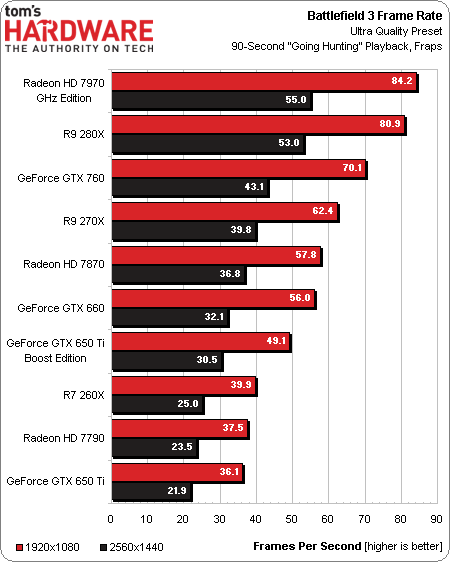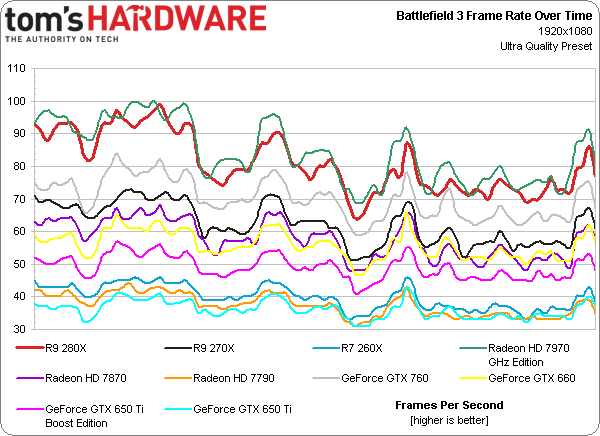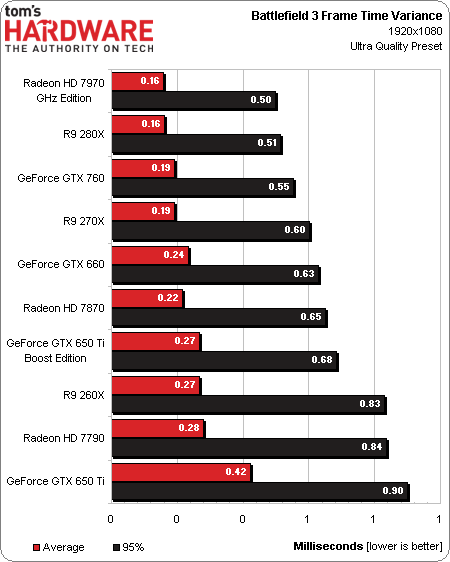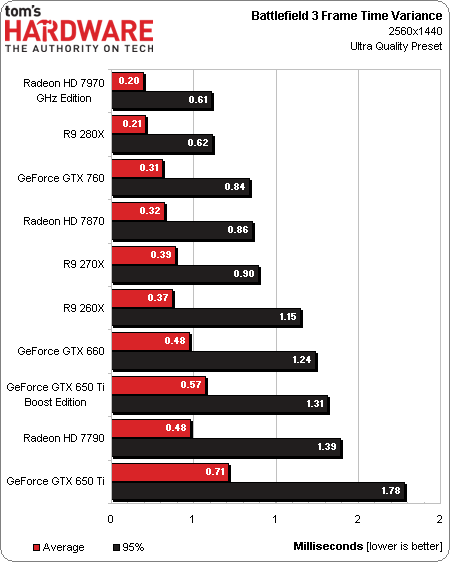AMD Radeon R9 280X, R9 270X, And R7 260X: Old GPUs, New Names
AMD is introducing a handful of new model names today, based on existing GPUs. Do the company's price adjustments make this introduction newsworthy, or will the excitement need to wait for its upcoming Radeon R9 290 and 290X, based on fresh silicon?
Results: Battlefield 3
Again, a $30 savings seems to be worthwhile, given the performance sacrifice you make going from Radeon HD 7970 GHz Edition to R9 280X. Then again, with vanilla 7970s already selling for $300 online, you didn’t exactly need to wait for a re-brand for access to Tahiti at a great price.
Although AMD fails to impress relative to its prior-generation products, it fares better against GeForce GTX 760. The R9 costs $50 extra, but is probably what you’d want in order to play Battlefield 3 smoothly at 2560x1440 using the Ultra detail preset. Really, the GeForce card is more of a match-up to AMD’s older Radeon HD 7950. But that model is going to disappear, and Nvidia doesn’t have anything else short of $400 to go up against the R9 280X at $300.
I’m not sure it’s worth spending an extra $20 for an R9 270X when the Radeon HD 7870 comes as close as it does. But you’ll probably want to choose the 7870 over Nvidia’s GeForce GTX 660, even at the adjusted $180 price point.
R7 260X’s advantage over the Radeon HD 7790 is marginal. Its lead over the GeForce GTX 650 Ti is similarly small. But the GeForce GTX 650 Ti Boost is quite a bit faster and only $10 pricier. That’s a smarter play for Battlefield 3 using the Ultra detail preset at 1920x1080.
Charting frame rate over time is good for monitoring dips into unplayable territory. At 2560x1440, you can see the R9 270X does keep minimum performance a bit smoother than the Radeon HD 7870 in a handful of passages. That could help make a case for spending the extra $30 on AMD’s higher-clocked board (or for simply overclocking your 7870).
There’s little of interest to report from our frame time variance charts. In single-card configurations, each of these solutions behaves itself.
Get Tom's Hardware's best news and in-depth reviews, straight to your inbox.
Current page: Results: Battlefield 3
Prev Page Results: Arma III Next Page Results: BioShock Infinite-
CaptainTom Wow what's with the AMD hate? As it stands they are doing the same thing Nvidia did except without the outrageous prices. The GTX 770 wasn't a great deal when the 7970 was $50 cheaper. Have fun trying to run BF3 with 2GB of VRAM...Reply -
slomo4sho Nothing revolutionary but better prices I suppose.Reply
The MSI R9 280X Gaming at $299 appears to outperform the GTX 770 at 1600P and is within margin of error at 1080P according to Techpowerup. Not a bad value at $100 less and still overclocks well:
http://www.techpowerup.com/reviews/MSI/R9_280X_Gaming/26.html -
jimmysmitty So long story short, if you have a HD7970GHz then these do nothing for you.Reply
Best to hold out till the reviews on the R9-290X I guess. But considering the specs I hope for at least 20% performance increases over a 7970. -
Shankovich What happened to Chris? I didn't see this kind of hate with all of the 700 series rebrands. Also, to the Canadians here, grab the $270 7970 GHz edition cards while you still can.Reply -
BigMack70 I don't like this new strategy AMD and Nvidia are taking of rebranding an old series at improved price points and then releasing only one new chip at a stupidly expensive price point.Reply
Are the days of (nearly) annual simultaneous full line GPU launches from $100-500 with a dual GPU chip to follow at $750-1000 really over? -
cangelini Hate? The R9 280X won an *award*. I think Tahiti at $300 is pretty much brilliant.Reply
I wrote one of the least flattering GTX 780 stories out there. I only identified a couple of situations where a Titan made any sense at all. And although the 760 *did* change the balance at $250, that card still didn't get an award. I liked the 770 for the simple fact that it delivered better-than-680 performance for close to $100 less.
The rest of AMD's new line-up is a lot like what exists already. Again, the 7870 is a better value than 270X. So what are you getting worked up over? The fact that I'm pointing out these aren't new GPUs? They're not. ;) -
Shankovich Ok Chris, I agree with you, sorry for the over reaction. But I really don't like how nVidia made price increases for some of the rebrands. Looking forward to your 290 and 290X reviews :DReply -
ingtar33 i'll take a 7950 at $129 thank you very much (or two). There is a major retailer selling them for that this week. Best buy all year. two 7950s for the price of one r9-280x? yeah... i'll do that all day every day.Reply -
tomfreak Radeon 7790 has true Audio = but not enabled boooooo = as a 7790 owner I somewhat disappointed :( . Anyone have any idea if we can crossfire 1GB 7790 and 2GB 260x?Reply -
net_nakul By the time a R9 380X comes out, the GCN Tahiti XT achitecture may be 4 years old (assuming end of 2015). AMD better come up with an awesome new architecture by then, considering the R&D time they have.Reply
That goes to you too Mr. NVIDIA





